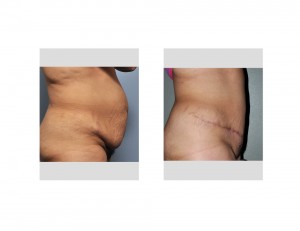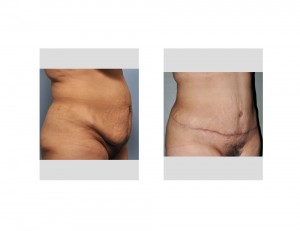Background: A tummy tuck is one of the most common and successful body contouring procedures. Between pregnancies and weight loss, the development of loose skin and fat on the abdominal wall is inevitable for many women. This usually appears as a loose overhang on the lower abdomen that hangs like a hammock depending upon its size. This overhang has become known as an abdominal pannus which signifies an apron-like deformity.
One of the unique types of abdominal pannuses has a somewhat familiar look. Any surgery previously done that leaves a vertical scar between the belly button and the pubis (e.g., old style c-section) creates a split down the middle of the pannus. Because a surgical scar often has little fat underneath it, and may even be stuck to the underlying fascia, this results in an indentation which results in a pannus divided into two halves. Patients often refer to this as having a ‘buttocks’ on their front side. The bigger the abdominal pannus is the more likely it appears like a pair of buttocks.
A tummy tuck always creates a low horizontal scar of variable lengths. That is the inevitable trade-off for getting rid of the abdominal pannus. Certain ethnic groups are at higher risk for adverse scar formation, most commonly hyperpigmentation. Intermediate skin pigments, such as Hispanics and Asians, are at such risk as their skin types have well known reactivity to incisions particularly those placed under tension.
Case Study: This 38 year-old Hispanic female wanted a tummy tuck. She had a prior c-section done in Mexico for the delivery of her two children. Between the two pregnancies and some small weight gain, she had developed a ‘butt’ appearance on her lower abdomen with the scar acting as a tether between the two halfs.


Case Highlights:
1) The clefted abdominal pannus (frontal butt appearance) is caused by a vertical scar between the belly button and the pubis.
2) A full or complete tummy tuck removes the entire deformed abdominal tissue to create a smooth and flat lower abdominal wall.
3) Tummy tuck surgery in Hispanics has a high propensity for hyperpigmented scarring which may require a secondary scar revision.
Dr. Barry Eppley
Indianapolis, Indiana



